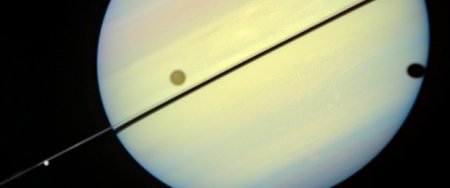
© E. Karkoschka & G. BaconA Hubble photo of Titan and Tethys transiting Saturn in 1995.
Something is about to happen on Saturn that's so pretty, even Hubble will pause to take a look. "On Feb. 24th, there's going to be a quadruple transit of Saturn's moons," says Keith Noll of the Hubble Space Telescope Science Institute.
"Titan, Mimas, Dione and Enceladus will pass directly in front of Saturn and we'll see their silhouettes crossing Saturn's cloudtops-all four at the same time."
Hubble won't be the only one looking. Amateur astronomers will be able to see it, too. The timing favors observers along the Pacific coast of North America, Alaska, Hawaii, Australia and east Asia. "I woke up at one o'clock in the morning to photograph Titan's passage across the disk of Saturn," says Go. "The sky was overcast, but I was fortunate to see the end of the transit through a break in the clouds. The emergence of Titan was really stunning because it gave the moon a 3D appearance!"
Transits like these are rare. "They only happen every 14 to 15 years when the orbits of Saturn's moons are nearly edge-on to Earth," says Noll. In 1995-96, the last time the geometry was right, Hubble photographed two (Titan and Tethys) and three (Mimas, Enceladus, Dione) moons transiting Saturn. This will be the first time the great telescope captures four.
The event begins on Tuesday morning, Feb. 24th at 10:54 UT (2:54 a.m. PST) when Titan's circular shadow falls across Saturn's cloudtops. About forty minutes later, the ruddy disk of Titan itself moves over the clouds.
"Titan is so big, you can see it just by looking through the eyepiece of a small telescope-no special camera is required," says Go.
One by one, the smaller moons Mimas, Dione and Enceladus will follow Titan. At 14:24 UT, all four satellites and their shadows will simultaneously dot Saturn's disk.
"To photograph the smaller moons, you'll need a mid-sized backyard telescope equipped with a good CCD camera," notes Go.
Hubble's observations are part of the Hubble Heritage Project, a 10-year outreach effort aimed at producing images of exceptional beauty for the general public. "Only 0.5% of Hubble's observing time is devoted to Heritage work," says Noll, one of the project's leaders, "so we're picky about our targets." He thinks the quadruple transit could rank among the best planet-shots in Hubble's archive.
The images could yield hard science, too.
"The transit of Titan will be of particular interest," says Noll. "Researchers plan to use Saturn as a backlight to probe the size and transparency of the giant moon's atmosphere." Hubble will also capture a rare view of the rings almost edge-on, a point of view that can reveal ring-warps, undiscovered satellites, and new information about the reflectivity of ring particles.
"Hard science can be beautiful."
Editor's note: To find Saturn on Feb. 24th, look southwest before sunrise. The planet is easy to see shining like a golden first-magnitude star in the constellation Leo: sky map. By cosmic coincidence, Feb. 24th is also the date Comet Lulin makes its closest approach to Earth--and the comet is right beside Saturn! Using a small telescope you can catch a comet, a ringed planet and a quadruple transit; it's a nice way to begin the day.

And you can bet all lifeforma on Saturn are gonna be happy we STILL cant see through our shit coloured glasses... Ho sorry for the typo!